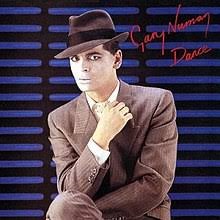Five of the best from Gary Numan
Five of the best from Gary Numan
- The Pleasure Principle (1979) - Features the hit single "Cars," which became Numan's signature song. This album was a success, reaching No. 1 on the UK Albums Chart. It was pioneering in its heavy use of synthesizers, making it a cornerstone of the electronic music genre.
- Replicas (1979) - Includes the single "Are 'Friends' Electric?" which topped the UK Singles Chart. Released under the band name Tubeway Army, this album also reached No. 1 on the UK Albums Chart. It helped define the synth-pop sound of the late 1970s and early 1980s.
- Telekon (1980) - Features the singles "We Are Glass" and "I Die: You Die." This album continued Numan's success, reaching No. 1 in the UK and solidifying his status as a leading figure in electronic music.
- Dance (1981) - Includes the single "She's Got Claws." Though more experimental and less commercially successful than its predecessors, "Dance" still performed well, reaching No. 3 on the UK Albums Chart. It marked a shift in Numan's sound towards more ambient and jazz influences.
- Savage (Songs from a Broken World) (2017) - Features tracks like "My Name Is Ruin." This album marked a significant resurgence in Numan's career, receiving critical acclaim and reaching No. 2 on the UK Albums Chart, his highest charting album in decades.
1. The Pleasure Principle (1979)

The Pleasure Principle marked a pivotal moment in electronic music. Known for its innovative use of synthesizers, the album helped define the synth-pop genre. Featuring the hit single "Cars," the album was a commercial success, reaching No. 1 on the UK Albums Chart. The Pleasure Principle stands out for its minimal guitar usage, relying instead on synthesizers and drum machines, which gave it a futuristic and mechanical sound that was groundbreaking at the time.
The album's influence can still be heard in modern electronic music, as it was one of the first to embrace technology in music production fully. Its themes of isolation and dystopia resonated with the post-punk generation, while the distinctive electronic beats and melodies made it accessible to mainstream audiences. Gary Numan’s work on The Pleasure Principle cemented his status as a pioneer in electronic music.
2. Replicas (1979)

Replicas, released under the name Tubeway Army, is a defining moment in the evolution of electronic and synth-pop music. The album combines a dystopian narrative with cold, mechanical sounds driven by synthesizers and drum machines. This futuristic approach was revolutionary, merging post-punk energy with electronic experimentation. Replicas includes the iconic single "Are 'Friends' Electric?", which topped the UK Singles Chart and became one of Numan's most recognizable songs.
The album explores themes of alienation, technology, and dystopia, reflecting the cultural anxieties of the late 1970s. Numan's robotic vocals and detached lyrics fit perfectly with the album's machine-driven soundscapes. Replicas was both a commercial and critical success, reaching No. 1 on the UK Albums Chart and establishing Numan as a pioneer in the electronic music genre. Its innovative use of synthesizers and dark themes made a lasting impact on both electronic music and pop culture, influencing generations of musicians to come.
3. Telekon (1980)

Telekon solidified his place as a leading figure in electronic music. Following the success of The Pleasure Principle, Telekon continued Numan's exploration of synthesizer-driven soundscapes, blending darker themes with more accessible melodies. The album reached No. 1 on the UK Albums Chart, making it his third consecutive chart-topping release.
Telekon is notable for its complex mix of electronic instruments, including synthesizers, along with the reintroduction of guitar and bass. This balance of analog and digital elements created a unique sound that resonated with both new wave and post-punk audiences. The album deals with themes of technological alienation and personal introspection, which aligned with the growing cultural fascination with dystopia and futurism.
With Telekon, Gary Numan expanded his musical range while maintaining the futuristic and robotic aesthetic that defined his early work. The album's success and influence further cemented Numan's role as a pioneer in electronic and synth-pop music.
4. Dance (1981)

Dance marked a shift in his sound, moving away from the heavy electronic and industrial beats of his earlier work. This album introduced more ambient and jazz influences, creating a slower, moodier atmosphere. Though it didn't reach the same commercial heights as his previous albums, Dance still reached No. 3 on the UK Albums Chart and demonstrated Numan's willingness to experiment with new styles.
The album is characterized by its use of fretless bass and a more stripped-back approach to synthesizers. Collaborating with musicians like Japan’s Mick Karn, Numan crafted a sound that was more introspective and avant-garde. Thematically, Dance continued Numan's exploration of alienation and technology but framed it in a more atmospheric, experimental way.
While it received mixed reviews at the time, Dance has since gained appreciation for its innovation, influencing later electronic and new wave artists. It remains a unique entry in Numan’s discography.
5. Savage (Songs from a Broken World) (2017)

Savage (Songs from a Broken World) marked a powerful return to form for the pioneering electronic artist. The album, which reached No. 2 on the UK Albums Chart, explores a dystopian world ravaged by climate change. The sound is a mix of industrial rock, dark synth, and cinematic elements, creating a tense and dramatic atmosphere. Numan’s distinct voice and layered production give the album a haunting quality that reflects its apocalyptic themes.
Savage is set in a future where society has collapsed, and Numan's lyrics focus on survival, desperation, and the impact of environmental destruction. Musically, the album blends modern electronic production with Numan’s classic sound, featuring heavy synthesizers, distorted guitars, and tribal beats. Its critical success revitalized Numan’s career, demonstrating his ability to stay relevant in a changing musical landscape. Savage is a testament to his enduring influence on electronic and industrial music, appealing to both longtime fans and new listeners alike.
Recent Posts
Queen studio albums: A Review
Phil Collins Albums Ranked & Reviewed – Complete Guide to Every Studio Album
The best of Massive Attack
Let’s Make Magic
Book Your Event DJ Now




